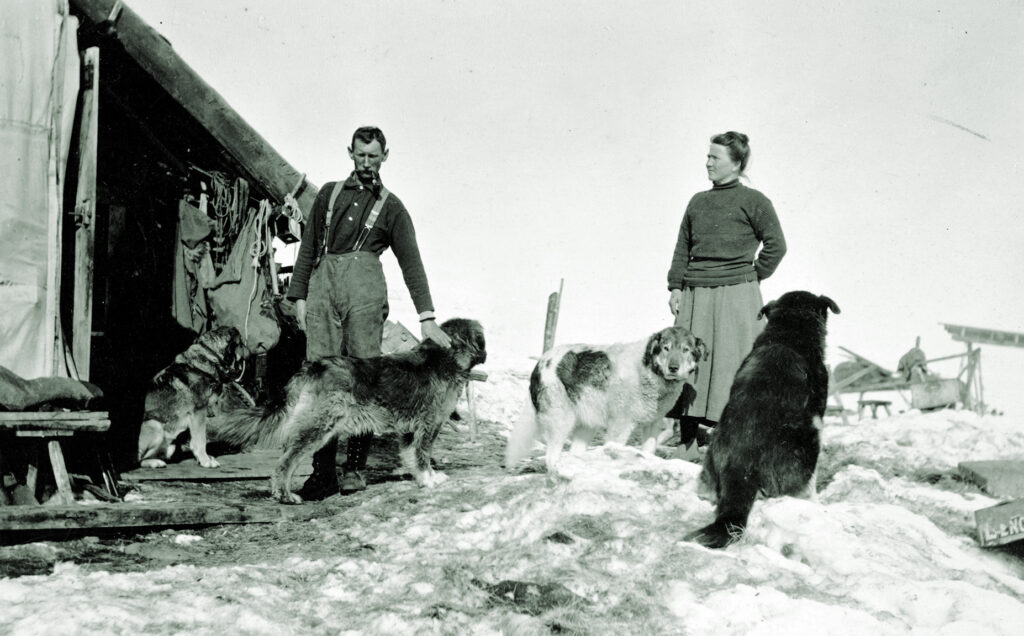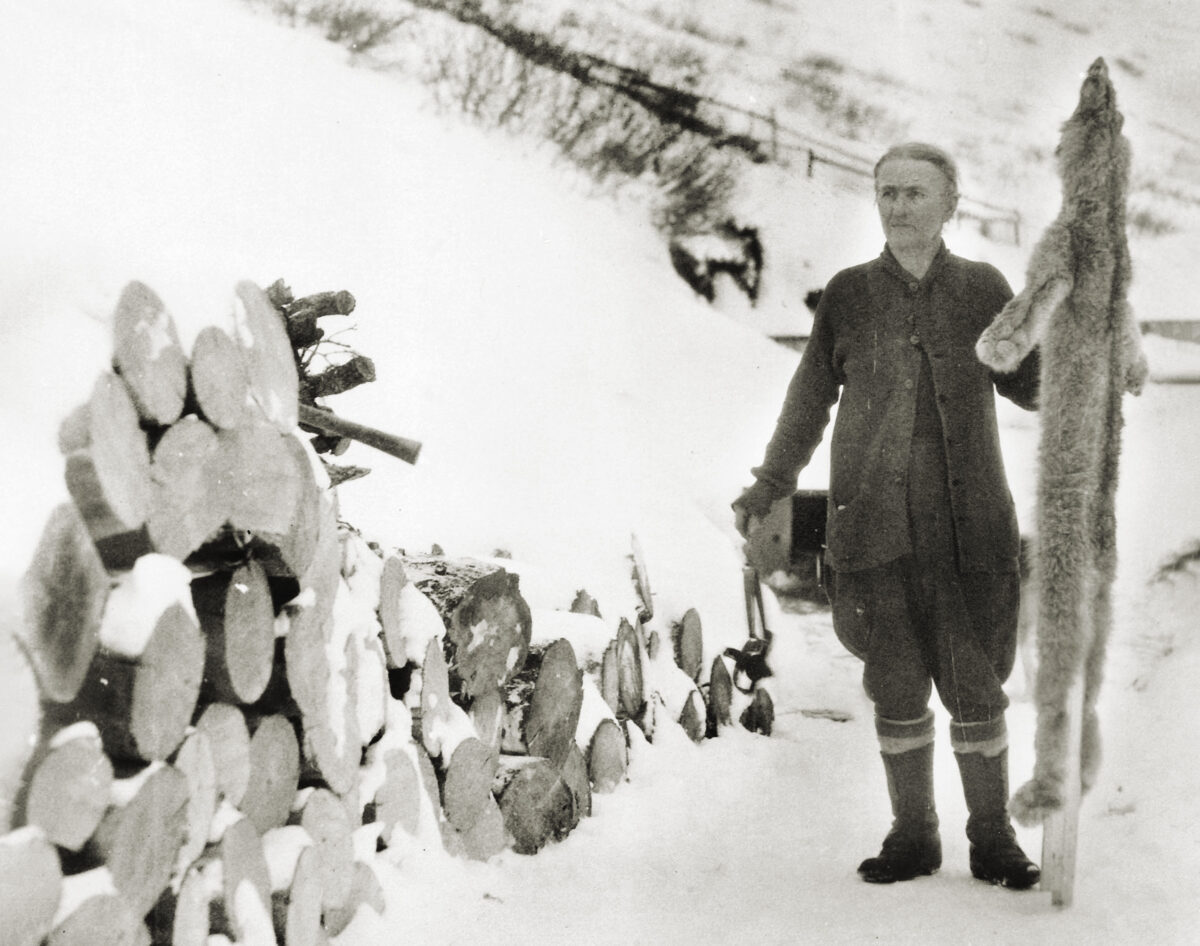“She was tough as grizzly bear claws,” one observer wrote about Fannie Quigley, who forged her own path from a dugout on the Great Plains to the Pacific Coast and then north to Alaska.
Born in Wahoo, Neb., on March 18, 1870, little Frances Sedlacek was known as “Fannie” from childhood. It was a childhood tempered with hard times. Wahoo was a village of largely Czech-speaking Bohemian immigrants from the Austro-Hungarian empire who in 1870 were being assaulted by the triple hardships of a locust plague, record-breaking blizzards and a seven-year drought. As if fate hadn’t stacked the deck against Fannie sufficiently, illness took her mother when the girl was only 5. Within a year her father remarried, and Fannie soon had three more siblings for whom to care, adding to her already heavy workload. Like many such children of hardship, she surely longed to escape the drudgery of life on her family’s windswept homestead.
So, at age 16 she left home to follow the westward-leading Burlington and Union Pacific railroads. As she cooked for the work crews, Fannie soaked up the spirit of the frontier. Though she spoke only her parents’ native Czech at home and had scarcely any schooling, she soon learned English from the roughneck workers. As might be expected, in and among the more traditional English words and phrases she picked up some pretty colorful exclamations. Those expressions only enhanced her rough-edged persona.
Fannie followed the tracks for more than a decade. When she finally ran out of west, she turned her gaze north, having heard the rumors of a gold strike in the Klondike region of Yukon Territory in northwestern Canada. It was a cinch most of the miners rushing toward potential riches hadn’t bothered to pack cooking supplies among their picks, shovels and pans. Hot meals, she reasoned, might be as precious to them as gold. By 1898 she’d scraped together the money for passage to Alaska.
GET HISTORY’S GREATEST TALES—RIGHT IN YOUR INBOX
Subscribe to our HistoryNet Now! newsletter for the best of the past, delivered every Monday and Thursday.
Some accounts suggest Fannie worked for a couple of years as a dance hall girl in a Dawson saloon. Whether true or not, she soon reverted to her skills as a cook. Packing a sled with a sheet-metal Yukon stove, a tent, cooking supplies and a shingle advertising Meals for Sale, she set out for the remote gold camps. As she didn’t have money to spare for dogs, little Fannie lugged the sled herself. Despite the intense physical effort, she found her hunch was right. Miners were drawn to her mobile diner like bears to a honey tree. Not content with merely cooking for a living, Fannie jumped into the prospecting game herself and started acquiring mining claims. She also staked her claim to a ruggedly handsome miner named Angus McKenzie, whom she married on Oct. 1, 1900. The couple soon opened a roadhouse near the settlement of Gold Bottom, southeast of Dawson.
According to reports in Dawson’s Daily Klondike Nugget, the McKenzies’ marriage fell somewhat outside the bounds of wedded bliss. They were said to mix it up regularly with fights resulting in mutual black eyes. Three years after they’d tied the knot, it unraveled, and Fannie stomped out the front door. That stomping extended into a 500-plus-mile hike down the banks of the Yukon River to Rampart, Alaska.
After prospecting around Rampart, Fannie pursued rumored gold in several neighboring camps. None filled her pockets, so in 1906 she followed another lead south to Kantishna, a camp in the shadow of towering Mount McKinley. Originally called Denali, a Native Alaskan word meaning “High One,” the mountain had been renamed by a prospector in 1896 in support of then presidential candidate William McKinley, despite the fact the politician had never, and would never, set foot in Alaska. (The Interior Department restored the name Denali in 2015.)
Between 1907 and ’19 Fannie staked some 26 claims. While most didn’t pan out, one thing did gleam for her in Kantishna—another good-looking fellow. Long-legged Joe Quigley was a locally known frontier jack-of-all-trades who combined the skills of hunting, carpentry, mining and blacksmithing. Fortunately, their pairing proved far less explosive than that of Fannie and her ex. On Feb. 2, 1918, the couple married and for the next two decades worked their Red Top Mine, leased other claims, and fed and boarded guests at their Kantishna residence.
The Quigleys made quite an interesting visual impression, with Joe topping 6 feet and Fannie not quite reaching 5. She more than compensated for her diminutive stature with her feisty personality. One day she and Joe ventured out separately to hunt. Joe returned to the cabin empty-handed, his shame only escalating at the sight of Fannie proudly dressing out the carcasses of two caribou, a bear and a moose. Never one to mince words, she tossed him her skirt. “Here,” she blurted, “you do the housework today. Gimme your pants.”

By necessity Fannie learned a wide range of wilderness skills. Another day Joe showed up with his nose split open in the wake of a bush plane accident. Without hesitation Fannie cleansed the wound and stitched it with catgut. “I sewed him the way I do my moccasins,” she later related, “with a baseball stitch.”
During her years as a Kantishna homesteader Fannie also became known as one of the best cooks in Alaska. Despite the brief 10-week frost-free growing season, her prolific garden provided a steady supply of vegetables, even in winter. She utilized the mine shafts and tunnels of the Red Top to keep her produce frozen year-round. Her recipes for blueberry or rhubarb pie included a step city slickers’ recipes didn’t list—mushing one’s dogs 125 miles to the nearest town (Nenana) for flour and sugar. The secret ingredient in those pies also took a little doing—shooting a nice fat bear and dragging it back to the cabin to be rendered into lard for her flaky crusts.
By the mid-1930s, whether due to environment or temperament, the Quigleys’ marriage was showing signs of wear and tear. In 1937 they leased their mining claims to the Red Top Mining Co. and split the income as part of a divorce settlement. Joe then headed to Seattle. Fannie kept the Kantishna cabin, where she died at age 74 on Aug. 22, 1944. Her legacy lives on. In 2000 Fannie was inducted into the Alaska Mining Hall of Fame, while the Quigleys’ old cabin remains standing and open to visitors within Denali National Park and Preserve.






